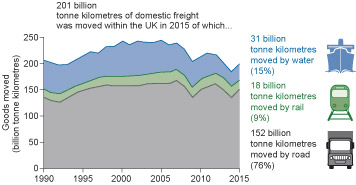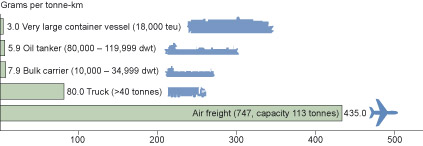2.1 The impact of logistics on the environment
When discussing logistics, both inbound and outbound logistics are considered. In other words, the movements involved in sourcing and replenishing the raw materials, components or finished goods needed for a business processes, as well as the movements of goods from an organisation to its customers, back to suppliers or out for disposal and recycling.
In the context of logistics, the prime concern tends to be pollution, or the impact of vehicle emissions into the atmosphere, onto the road or into the water. Vehicle emissions generally relate to burning fossil fuels and the gaseous and particulate emissions from the engines.
To get a sense of the scale of the impact that these emissions have on the environment, let’s have a look at the UK government’s transport statistics from 2016. Figure 3 shows the volume of freight moved each year. (A ‘tonne kilometre’ is the unit representing one tonne moved one kilometre, taking into account both weight and distance. So, 1 tonne moved 50 kilometres is the same as 50 tonnes moved 1 kilometre in this chart.) The chart shows that 76% of the freight moved in the UK was by road, and that that totalled 152 billion tonne-kilometres.
If you link the tonne-kilometres to the statistics of greenhouse gas emissions, you can see that in 2014, 514.4 MtCO2e (million tonnes of carbon dioxide equivalent) were released into the environment – 23% of which comes from us, transporting boxes of stuff from one link in the supply chain to another.
Now consider the logistics in your own organisation. In terms of raw materials, components and finished goods, what weight of goods is moved and how far? If you are based in the UK, what was your organisation’s contribution to the 152 billion tonne-kilometre figure of road transport? Was that contribution fully justifiable? To assess that, it is not only the weight and distance of the freight that needs to be considered; the way that the freight is transported is a key factor, as Figure 4 demonstrates.
In the discussion about the impact of logistics, we have predominantly focused on emissions by transport vehicles. We have not considered the environmental impact of constructing new roads, railways, airports or ports. These tend to be out of the direct control of the organisation, but are a result of the aggregate demand.
Let’s continue our discussion now by looking at the environmental impact of manufacturing and production.


